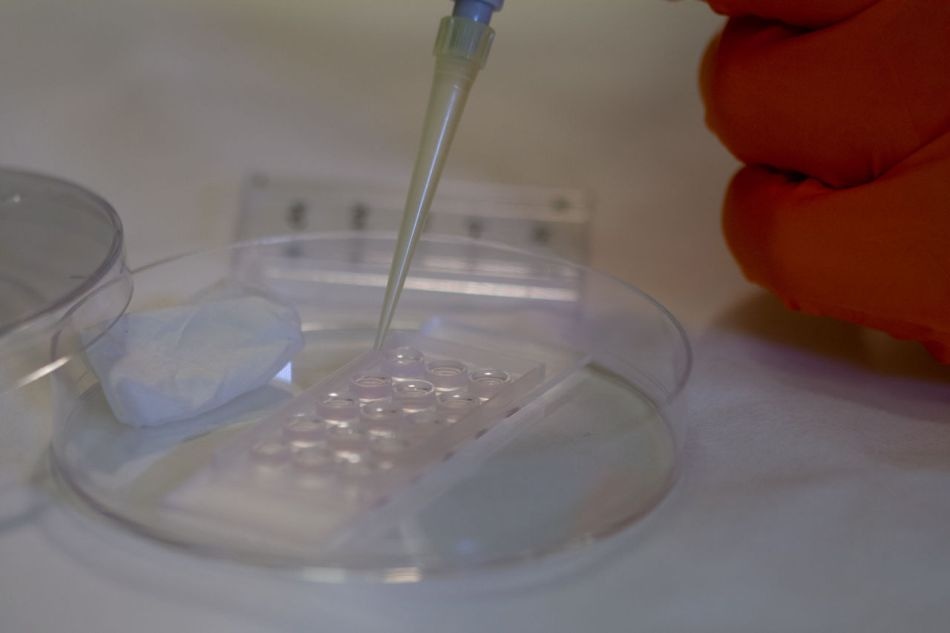Feb 13 2019
Researchers at Linköping University have developed a new technique to produce hydrated materials, hydrogels, that have properties analogous to the natural environment surrounding the cells in the body. The material can be tailored to meet different needs of cell types that are difficult to culture and to develop organ-like structures on a microchip.
 The material consists of two components that are mixed in water, together with living cells. A spontaneous chemical reaction takes place that causes the components to form a hydrated gel, a hydrogel, similar to the naturally occurring matrix. (Image credit: Karin Söderlund Leifler)
The material consists of two components that are mixed in water, together with living cells. A spontaneous chemical reaction takes place that causes the components to form a hydrated gel, a hydrogel, similar to the naturally occurring matrix. (Image credit: Karin Söderlund Leifler)
Lab-cultured cells serve a wide range of applications, one among them is testing if different new substances cause harm to the cells. A fast-evolving method called organ-on-a-chip involves culturing cells from human organs on tiny chips by supplying nutrients and oxygen. Researchers are trying to create models of increasing complexity that mimic the way how tissue or complete organs work in the body. Such models can be used in several fields of medical research—for example, testing potential medicines—and may replace some animal experiments in the longer run.
However, culturing human cells is not simple. They usually have extremely specific conditions, and die easily. In the body, a supporting structure called a matrix surrounds the cells. This is a kind of hydrated gel, and primarily contains carbohydrates and proteins. The environment of the cells is different for each tissue type and has a significant effect on cell function. Scientists at Linköping University are creating soft materials that more closely mimic the natural environment of cells in the body, in order to be used in cell culture.
Our new material allows the properties to be adapted across a wide range. New functionalities, such as small protein fragments that the cells need, can be incorporated, such that even picky cells can replicate and function.
Daniel Aili, Associate Professor, Department of Physics, Chemistry and Biology, Linköping University.
Daniel Aili together with Carl-Fredrik Mandenius, who also works in the Department of Physics, Chemistry, and Biology, has led the research.
The material, which is reported in an article in Biofabrication, includes two components that are blended in water, along with living cells. A chemical reaction occurs due to which the components produce a hydrated gel, a hydrogel, which is analogous to the naturally occurring matrix. This chemical reaction occurs spontaneously and does not impact the cells. The researchers have conducted wide-ranging tests of the hydrogel properties and compared it with other widely used materials.
“We can adapt the mechanical properties of the hydrogel within a wide range. We can also control the speed of formation of the gel: it’s important that it doesn’t occur too rapidly or too slowly,” says Daniel Aili.
In the testing of new pharmaceutical substances, the liver is considered vital because most of the drugs that are taken by humans are processed in the liver. Therefore, the scientists have tested using the hydrogel to develop a human liver-on-a-chip, using liver cells obtained in culture from stem cells. The researchers were able to tailor the material in such a way that even these quite demanding cells could multiply and function.
Proteins are not included in the basic configuration of the hydrogel, but the scientists incorporated in the material a synthetic fragment of a key protein present in the tissue surrounding the human liver. Upon inclusion of this protein-mimicking component to the hydrogel, the liver cells on the chip began producing albumin, just like the liver does in the body.
The principal significance of our material may be in the development of useful models of the liver, which can be used to simplify the early stages of drug development. Our hydrogel is extremely interesting for anyone who wants to have control of the contents of the material in which the cells are cultured. And it’s easy to adapt to different types of cell and tissue.
Daniel Aili, Associate Professor, Department of Physics, Chemistry and Biology, Linköping University.
The financial support for this work is provided by the EU Innovative Medicines Initiative Joint Undertaking, the Swedish Research Council, the Swedish Foundation for Strategic Research (SFF), the Carl Trygger Foundation, the Knut and Alice Wallenberg Foundation, the Swedish Government Strategic Research Area in Materials Science on Functional Materials at Linköping University.